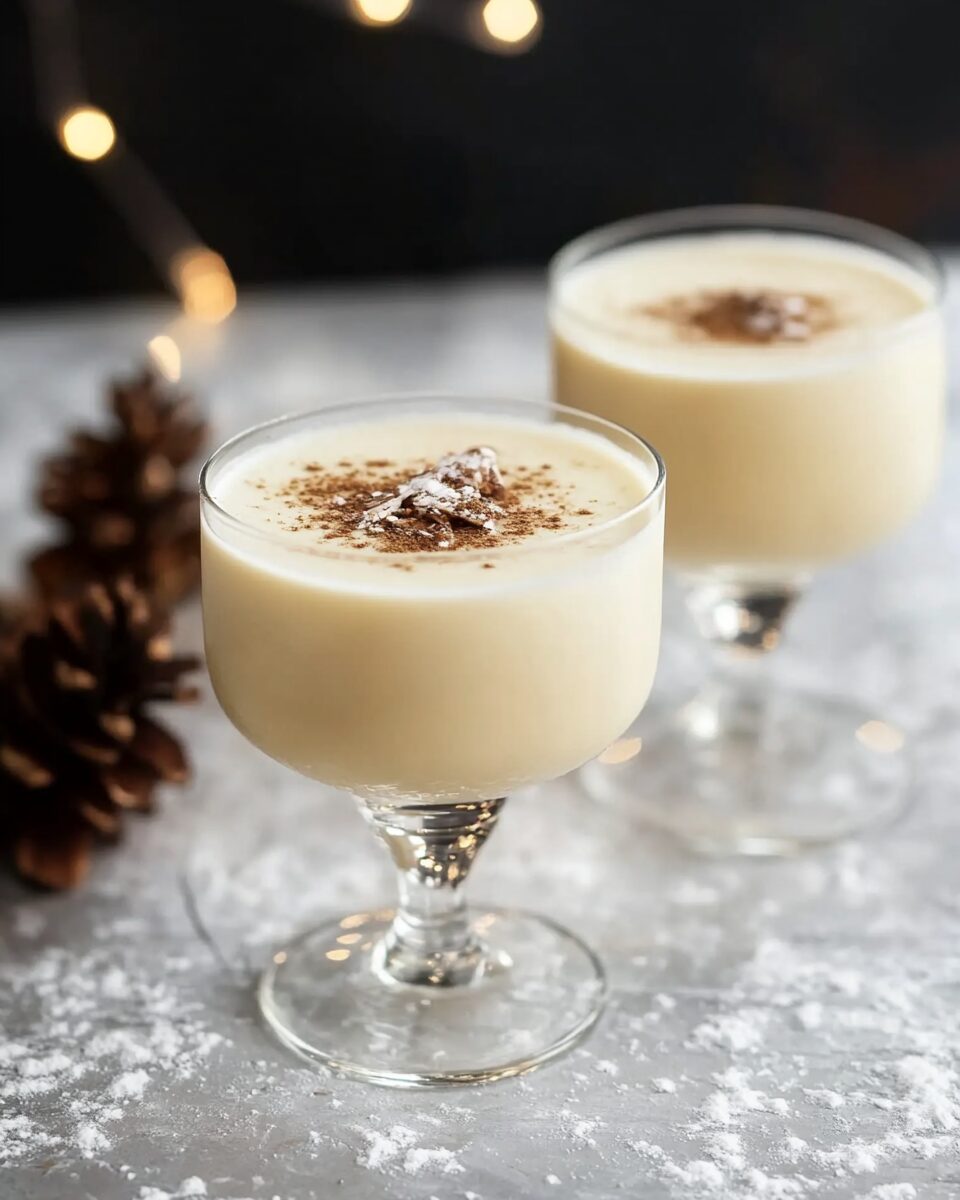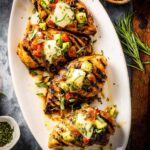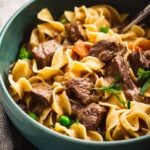Homemade eggnog is the quintessential holiday drink, bringing warmth and festive cheer to every sip. This creamy, custard-like beverage is enriched with nutmeg and vanilla, offering a luxurious taste that’s both comforting and celebratory.
Perfect for holiday gatherings or quiet evenings by the fire, this eggnog recipe is as versatile as it is delicious. Enjoy it spiked with spiced rum for a grown-up twist, or keep it kid-friendly with whipped cream and cinnamon on top. Either way, it’s a surefire way to spread holiday joy.
Full Recipe:
- 6 large egg yolks
- 1/3 cup sugar (increase to 1/2 for a sweeter version)
- 3 cups whole milk
- 1 cup heavy cream (or half-and-half for a lighter option)
- 1 teaspoon vanilla extract
- 1/2 teaspoon nutmeg
- Pinch of salt
- Ground cinnamon (optional, for garnish)
- Spiced rum or bourbon (optional, for an adult version)
Directions:
- In a medium bowl, beat the egg yolks and sugar together until the mixture lightens in color and the sugar dissolves.
- In a large saucepan, combine milk, nutmeg, and a pinch of salt. Heat over medium to medium-high heat until the milk just begins to boil, stirring frequently to prevent burning. Remove from heat.
- Slowly temper the egg yolks by whisking in 1 cup of the hot milk mixture, stirring constantly to avoid cooking the eggs.
- Gradually whisk the tempered egg mixture back into the saucepan with the remaining hot milk, continuing to stir constantly.
- Return the saucepan to medium heat and cook, stirring frequently, until the mixture thickens slightly and reaches 160°F. Do not let it boil.
- Remove from heat and pour the mixture into a large glass or metal bowl. Chill for at least 1 hour.
- Once cooled, whisk in the cream, vanilla extract, and alcohol (if using). Refrigerate for at least 2 hours or until thoroughly chilled.
- Serve cold, garnished with a sprinkle of ground nutmeg or cinnamon and an optional dollop of whipped cream.
Prep Time: 15 minutes | Cook Time: 20 minutes | Chill Time: 3 hours | Total Time: 3 hours 35 minutes
Calories: 315 kcal | Servings: 6 servings
The History of Eggnog and Its Evolution
Eggnog, a creamy and spiced beverage, has deep roots in holiday traditions across the globe. Originating in Europe as a posset—a warm drink made with milk, ale, or wine—it was embraced by aristocrats who had access to milk and eggs, rare commodities at the time. The drink later crossed the Atlantic, where rum replaced the wine or ale, creating a more affordable and longer-lasting version. It soon became a staple during holiday celebrations in North America. Over the years, eggnog has transformed from its humble beginnings into a versatile and widely loved festive beverage. While traditional recipes included raw eggs and alcohol as a preservative, modern variations often use cooked methods to ensure safety, making the drink accessible to everyone, including children and those who prefer non-alcoholic options.
Why Homemade Eggnog is a Holiday Must-Have
While store-bought eggnog is convenient, homemade eggnog offers an unparalleled richness and depth of flavor that packaged versions simply can’t match. The creamy texture and customizable sweetness are just the beginning. With homemade eggnog, you can control the ingredients, tailoring the recipe to suit your dietary preferences, whether that means using low-fat milk, dairy-free alternatives, or adjusting the sweetness to your liking. Another benefit of homemade eggnog is the opportunity to create a festive experience. Making it from scratch fills the kitchen with warm, holiday aromas of nutmeg and vanilla, setting the perfect mood for the season. Plus, it’s a creative way to connect with family traditions or start new ones.
Tips for Perfecting Your Eggnog
Use Fresh, Quality Ingredients: The flavor of eggnog heavily relies on the quality of its ingredients. Fresh eggs, high-quality vanilla extract, and freshly grated nutmeg elevate the drink to gourmet status.
Achieve the Perfect Consistency: For a smooth and creamy texture, pay close attention to the cooking process. Constant stirring and slow tempering of the eggs are key to avoiding lumps or scrambled eggs.
Experiment with Variations: Traditional eggnog recipes call for milk, cream, and eggs, but you can get creative. Try almond milk for a nutty flavor or coconut milk for a tropical twist. For a lighter version, skip the cream or use a half-and-half mixture.
Serving Tips: Serve eggnog chilled, in festive glasses, and garnish with a sprinkle of cinnamon or nutmeg. For an elegant touch, add a dollop of whipped cream or a cinnamon stick.
The Role of Eggnog in Holiday Traditions
Eggnog is more than just a beverage—it’s a symbol of holiday cheer and togetherness. In many households, the act of preparing and sharing eggnog marks the beginning of the festive season. It is often served at holiday parties, family gatherings, and cozy evenings by the fire. The drink’s rich, indulgent taste embodies the essence of the holidays, making it a favorite for celebrations. Eggnog also offers an opportunity to honor traditions and create memories. Whether you’re preparing it as a family or sharing it with loved ones, the drink serves as a festive centerpiece that brings people together.
Modern Variations of Eggnog
Today’s eggnog recipes are as diverse as the families who enjoy them. Beyond the traditional spiced version, creative adaptations include:
Vegan Eggnog: Made with almond, soy, or oat milk and thickened with cashew cream or coconut cream, this version offers a dairy-free option without compromising on flavor.
Spiked Eggnog: A dash of spiced rum, bourbon, or brandy transforms eggnog into an adult-friendly indulgence, perfect for holiday parties.
Flavored Eggnog: Chocolate, caramel, or peppermint can be added to create unique seasonal twists on the classic recipe. These variations demonstrate how eggnog can be tailored to fit modern tastes while maintaining its festive charm.
Health Considerations and Customizations
For those mindful of their dietary intake, eggnog can be adapted to be healthier. Lower the calorie count by using skim milk or almond milk, and reduce sugar levels to make it more diabetic-friendly. Pasteurized egg products can also be used for safety, especially when preparing non-alcoholic versions for children. If you’re concerned about allergens, substituting dairy with plant-based milks or avoiding certain spices can make the drink more inclusive. By customizing the recipe, eggnog becomes a treat that everyone can enjoy.
Pairing Eggnog with Holiday Foods
Eggnog pairs beautifully with an array of holiday dishes, from sweet to savory. Its rich and creamy profile complements desserts like gingerbread cookies, fruitcake, and pies. On the savory side, it can balance the flavors of spiced nuts, cheese platters, or roasted meats. Offering eggnog alongside your festive spread enhances the overall dining experience, ensuring a cohesive and indulgent holiday meal.
Conclusion: A Timeless Holiday Tradition
Eggnog holds a special place in the hearts of holiday enthusiasts. Its creamy texture, warm spices, and nostalgic charm make it a must-have for festive celebrations. Whether enjoyed as a non-alcoholic family favorite or a spiked indulgence for adult gatherings, eggnog brings warmth and joy to the season. Crafting your own eggnog at home allows you to embrace the tradition while tailoring the recipe to suit your tastes. It’s more than just a drink—it’s a symbol of holiday cheer, a bridge between generations, and a testament to the joys of sharing good food and good company. As you prepare your holiday menu, consider adding homemade eggnog to the mix. It’s a timeless treat that embodies the spirit of the season.





